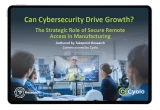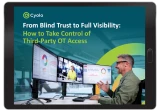Table of Contents
What happens when you hook operational technology (OT) systems up to an information technology (IT) network and connect them with powerful software?
You get new ways to automate processes, collect valuable data, and improve your operations.
But cyberattackers also get new avenues for infiltrating your OT environment – and taking control of the critical systems running your factory floor, power plant, or water treatment facility.
What Are Cyber-Physical Systems (CPS)?
If you’ve used an OT device that is connected to a network and collects some form of data, then you’re already familiar with cyber-physical systems – even if you’ve never used this specific term.
A cyber-physical system (or CPS) is a system that links computational elements (like data analysis software) with physical devices through a network.
CPS are the building blocks of smart factories. They help plants monitor and control production, get different parts of your facility working together, and automate repetitive tasks.
If you’re using robotics, taking advantage of the industrial internet of things (IIoT), or running a supervisory control and data acquisition (SCADA) system, then you’re using a CPS.
Cyber-Physical Systems are Increasingly Under Threat
Remember the part in Skyfall when the villain infiltrates MI6’s network and triggers an explosion? Using cyber systems to cause catastrophic damage to the physical world?
Sure, it’s a little over the top. But it’s not that far away from the kind of cyber-physical attacks that we’re now seeing in the real world.
Take, for example, the attack on the Oldsmar water treatment plant in 2021, in which a cyberattacker hacked the city’s water system.
The attacker was nearly able to increase the level of sodium hydroxide in the water to lethal levels – potentially poisoning 15,000 local residents without setting foot inside the plant. Just the sort of thing you’d expect from a modern-day James Bond villain.
We’re used to worrying about IT networks getting hacked. But, since OT systems were only relatively recently connected to each other or the internet, we tend to worry less about the potentially catastrophic consequences of attacks on cyber-physical systems.
But stop and think for a moment about all the processes controlled by CPS in your facility – and what an attacker could do with access to them.
2024 research found that 27% of businesses surveyed had suffered from a cyberattack on their CPS that did more than $1 million in damage. And that’s not even considering the human and safety impacts of a cyber-physical system attack.
These kinds of attacks used to feel like something out of science fiction – or at least a pretty cheesy action movie. But they’re becoming increasingly common in the real world. And, since James Bond isn’t here to save the day, organizations need dedicated remote access security solutions that can help them save themselves.
Can’t IT Security Solutions Protect Cyber-Physical Systems?
But wait – can’t the IT security tools you already have in place protect you from cyber-physical threats? After all, CPS are made up of OT and IT. Shouldn’t a solution that works for one also work for the other?
Unfortunately, this isn’t the case. IT security solutions typically aren’t suited to ensuring secure access to OT and CPS due to a few key limitations:
Required patching and updating - Most IT security solutions can’t keep up with emerging security threats without patches and updates which require you to take your system offline temporarily. But for CPS, this downtime could bring a production line grinding to a halt, interrupt supply chains and service delivery for customers, or create a safety issue that puts employees and the public at risk.
Cloud connectivity - IT security solutions frequently rely on internet connectivity to transmit information and implement updates. But CPS often aren’t connected to the cloud – which makes it very difficult for IT solutions to provide comprehensive protection.
Post-access visibility and control - IT security solutions generally focus on ensuring that the right people get access to the right assets. This is certainly important, but it leaves a gaping black hole – visibility and control over what users do after they connect. And when CPS and critical infrastructure are part of the equation, you need to know exactly what’s happening inside your network at all times – and ideally have the ability to limit or restrict user activity and terminate any suspicious sessions in real-time.
Physical safety isn’t prioritized - If your IT security solution accidentally locks the wrong person out of a piece of software, it’s an inconvenience to be sure. But the consequences of a mistimed lockout, a slow-loading MFA tool, or an overcomplicated password protection process in a CPS environment could be disastrous. If a technician isn’t able to access a critical device at a crucial moment, it could threaten the safety of your workforce or the wider public.
These are just some of the reasons that IT security tools don’t provide sufficient protection for OT and cyber-physical systems. The recent blog, Why the IT Security Toolkit Does Not Work for OT, explores this topic in much more detail.
Cyber Threats are Evolving. Your CPS Security Should, Too
Recognizing that CPS need purpose-built security solutions is an important first step. But the thought of overhauling your security strategy to include cyber-physical systems probably sounds pretty overwhelming.
You might expect that adding protection for CPS will require a full reconfiguration of your infrastructure. Shutting down your vital production systems. Losing productivity and money. And some vendors may indeed ask for such a total overhaul.
But thankfully, with the right vendor, solution, and approach, upgrading your secure access strategy to include CPS doesn’t actually need to be painful or disruptive.
The Cyolo PRO (Privileged Remote Operations) access solution is designed specifically to meet the distinctive needs of OT and CPS environments. Which means that unlike legacy Secure Remote Access (SRA) solutions, which were built for IT and only later adapted for OT, Cyolo PRO ensures secure access to critical assets with no need to replace existing systems, disrupt operations, or even change current work routines.
On the contrary, Cyolo PRO fits smoothly into your existing infrastructure – no change management required. It’s easy to install across multiple sites and can be deployed in any architectural setup (cloud-connected, on-prem, or offline).
So you get to take full advantage of your cyber-physical systems without letting cybercriminals do the same.
To learn more about choosing the best secure access solution for your OT and CPS environments, check out the Manufacturers’ Guide to Secure Remote Access for OT.
Don't work in manufacturing? Don’t let the guide’s name fool you. Whether you’re in energy, oil & gas, or any other industrial sector, this guide will help you ask the right questions, spot the wrong answers, and select a solution that fits your needs.
The Manufacturers’ Guide to Secure Remote Access
8 Tips for Choosing a Future-Proof Solution

Jennifer Tullman-Botzer
Author
Jennifer Tullman-Botzer has over a decade of experience in cybersecurity marketing and is as tired as you are of hackers-in-hoodies stock images. She joined Cyolo in 2021 and currently serves as Head of Content. Prior to Cyolo, Jennifer worked in a variety of marketing roles at IBM Security. She lives in Tel Aviv, Israel.

Subscribe to Our Newsletter







